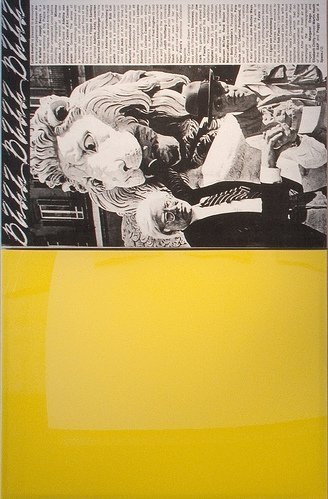Egan Frantz
dal 26/2/2010 al 23/4/2010
Segnalato da
26/2/2010
Egan Frantz
Cueto Project, New York
Revision 1: All Quiet on the Western Front. Frantz's practice is regimented by systematic processes, built up by a dynamics of both the materials and the language invested in them. At the same time, there is a sense of history and reverence for other artists. Trained as a photographer, Frantz employs a knowledge of camera-based image making and printing technologies, while conceding that were he trained in another field.

There is an intermediary state between ice and running water – when water begins to fashion itself into needles, when it still cracks and yields under the hand plunged into it.
- Remy de Gourmont
The textual reference of the title functions as a kind of third term for the installation as a whole. There is in this work something of the intimacy of books: the material and atmospheric presence of (a) text. We find a drip or a tear, for instance, that breaks the frame in his photograph of an Yves Klein catalogue, so as to perhaps spring a leak in the subject.
Taking the appearance of an Ellsworth Kelly or even an inkjet print, deconstructed and parsed into its pure values, the colors in MK, PK, LK, LLK, C, M, LC, LM, Y remain representations of the printer's palette. Frantz commands his printer to print each cartridge-color fully aware that it will mix several, if not all of the inks at the machine's disposal, to print the very colors contained in each cartridge. As such, each color contains the trace of all the others. It is just another image.
Ostensibly silent, his ongoing Sidesteps' are produced in discreet, cacophonous stumbles. Each surface is achieved in a single backwards fall in which Frantz drags a darkroom squeegee across a wet, freshly printed image and onto a blank page. This re-dispersion of the image generates what resembles an entirely new structure. In many of the works on display, as if by-products to the event, Frantz makes a horizontal move into painting.
From the back of the gallery bumps a "mashup" by DJ Eddie Def playing call and response with Frantz's numbers in 13 Figures and K.I.T.T.Y. Jam. The simple system of making 13 works with the numbers 1-13 supplies a connective tissue to Def's use of the electrofunk beat.
Previously exhibited as stacks, and most recently as a continuous line enclosing the viewer, the Petroleum Pictures are installed for their third iteration. The staging comes from a scene in which the boys in Erich Maria Remarque's All Quiet on the Western Front witness at least a hundred, freshly built coffins stacked alongside a schoolhouse. Frantz notes that "the passage reads like one of Donald Judd's reviews."
Within this choreographed setting there is a clear shuttling between iconographic contents and procedural imperatives. Frantz's practice is regimented by systematic processes, built up by a dynamics of both the materials and the language invested in them. At the same time, there is a sense of history and reverence for other artists: the union of Joseph Beuys and Andy Warhol is suggested; there is an image of Yves Klein making a fire painting with a fireman in one work, and an argument between Piet Mondrian and Salvador Dali in another.
Trained as a photographer, Frantz employs a knowledge of camera-based image making and printing technologies, while conceding that were he trained in another field, "the work would be distinctly different but essentially the same."
While we may lament the loss of the photography of silver halogens, embraced for its direct emanation of the referent, Frantz's practice extends the analog discourse that might be nearing extinction.
Egan Frantz was born in 1986 in Connecticut and lives and works in New York. He received his B.A. in Art and Literature from Hampshire College (2009, Prof. Robert Seydel), and attended the general studies program at The International Center of Photography (2008). This exhibition marks a year of work since his first solo exhibition, ALL QUIET ON THE WESTERN FRONT, Amherst Massachusetts. He is the founder of Numbers Press, a small, independent press publishing artist's editions at the intersections of art and literature, and has exhibited in previous group shows at Dinter Fine Art, The Camera Club of New York, and The International Center of Photography Education Gallery.
Opening Reception: Saturday, February 27th 6 - 8 PM
Cueto Project
551 W 21st Street - New York, New York 10011
Tuesday - Saturday : 10 am - 6 pm



